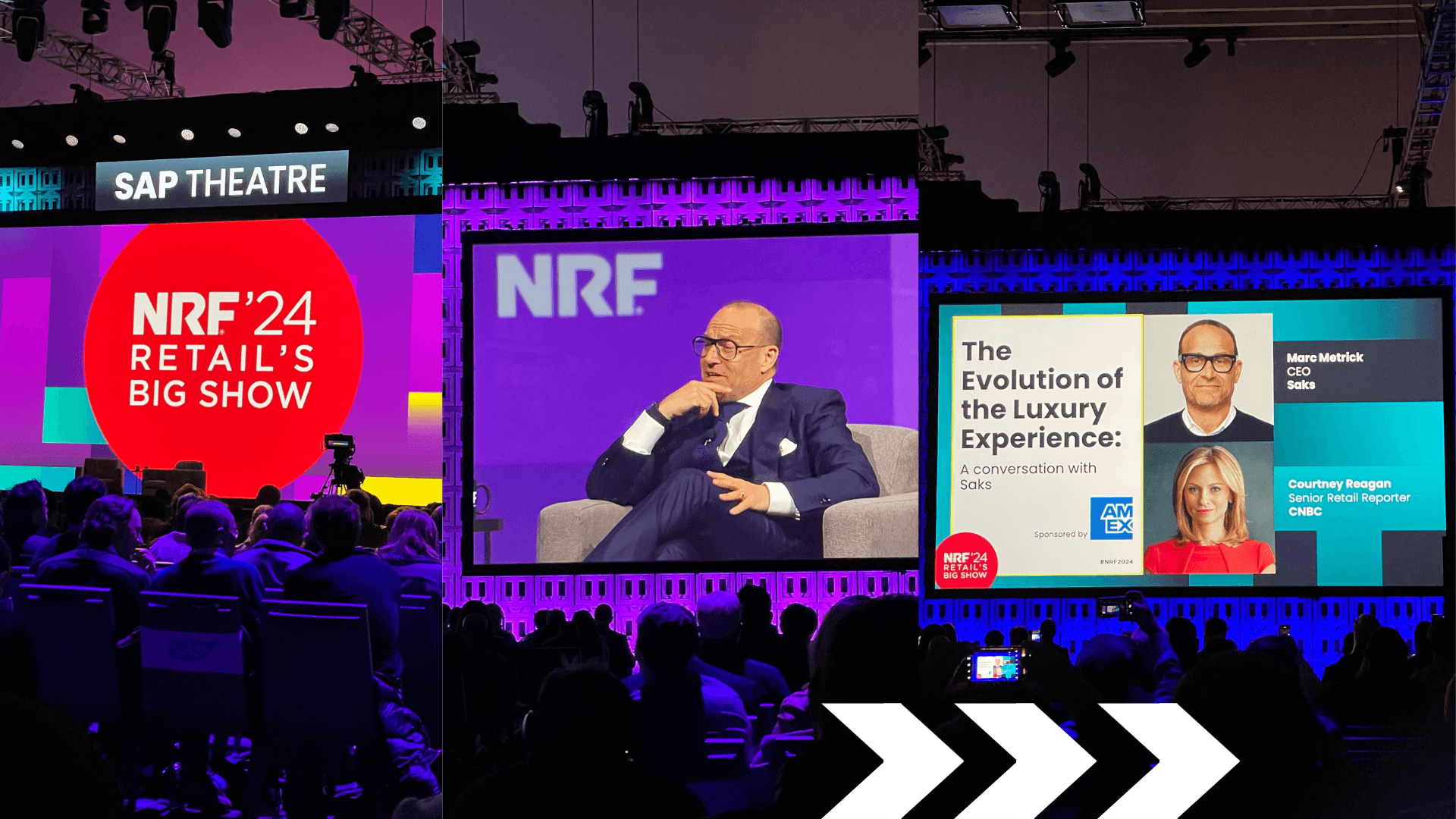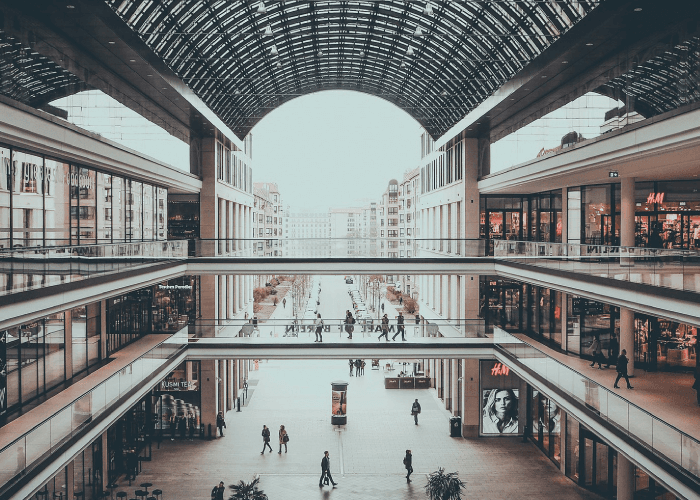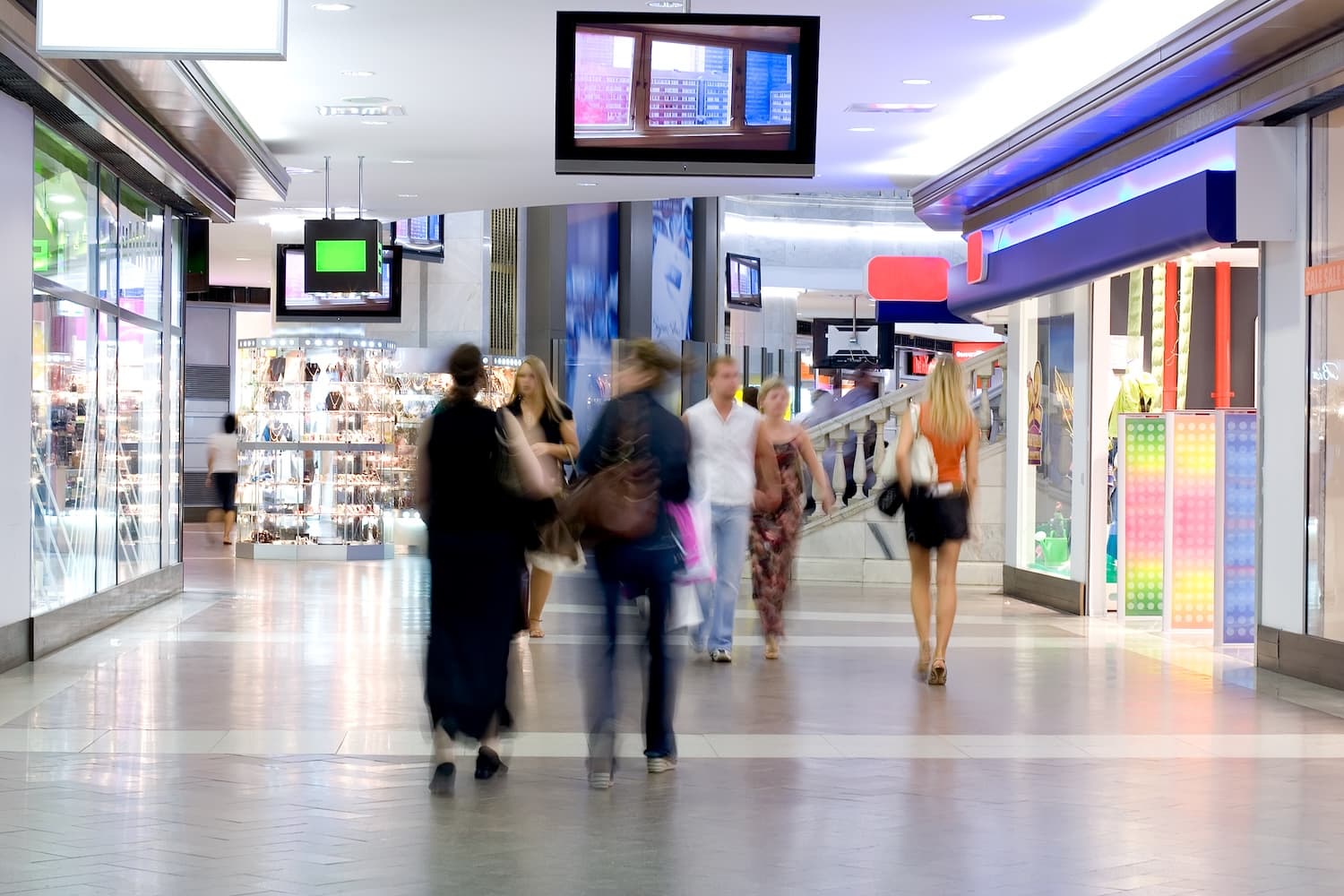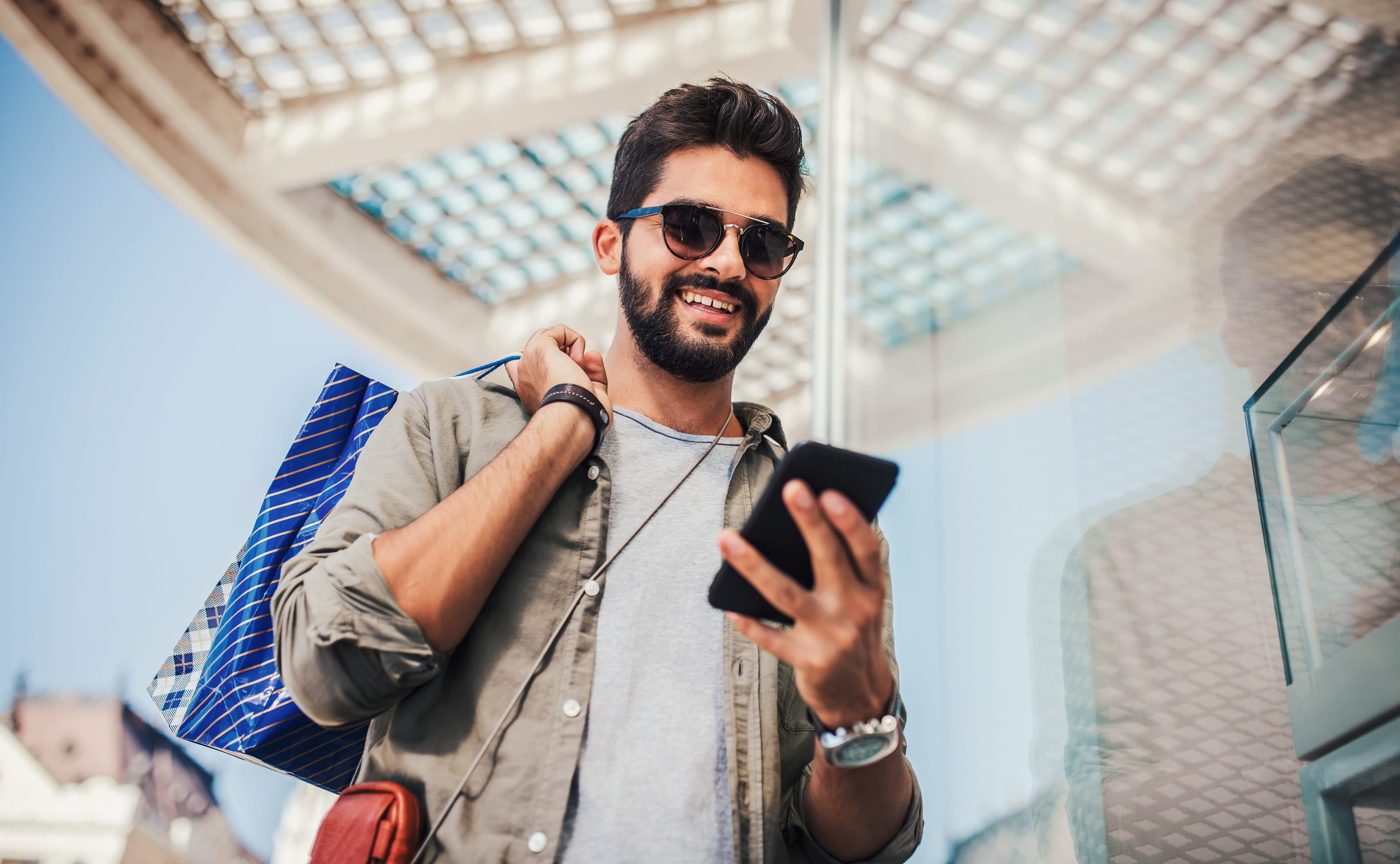The Pulse: NRF Day Three, 16 January Recap

On this page
The final day of the annual NRF Big Show did not disappoint. The show finished strong with insightful keynote addresses, invaluable networking opportunities, and that signature New York razzle-dazzle. Here’s what you may have missed today at the show.
READ MORE: What Lies Ahead For Retail Media Networks In 2024
Keynote Callout: The Next Iteration Of Luxury Retail
Today’s spotlight is on Marc Metrick, CEO of Saks, as he sat down with Courtney Reagan, Senior Retail Reporter at CNBC, to discuss Saks’ evolution. Marc leads the largest luxury e-commerce platform in the U.S. after playing a key role in establishing Saks as a pure-play digital luxury platform in March 2021. The retailer strives for innovation through data-driven personalization and AI, and is currently personalizing up to 90% of customer interactions online.
Saks’ operating model changed 3 years ago, and it now operates largely as a standalone e-commerce company. This serves as a complete reinvention of the company’s ways of working. Marc explained that this is an evolution, not an abandonment of the original company, as was first feared. The current focus is meeting the consumers online, where they want to be, especially younger generations of luxury shoppers. “Innovation is what drives this industry,” he noted.
The maturation of the digitally-native customer is a key concern for the brand. Younger consumers are now aging into luxury, financially and professionally. Online discovery and purchasing feel more accessible to emerging luxury consumers. Saks aims to grow with these consumers over time and create ever-increasing lifetime value. Online meets customers earlier in the buying journey. This is a democratization of luxury retail to make it feel more accessible and convenient. In essence, it de-fangs this heritage luxury retailer. However, “Luxury is always going to need a physical carnation to express what these brands are,” says Marc.

The goal is to deliver the best possible consumer experience at every touchpoint, and physical retail remains a key revenue driver. Brick-and-mortar turnover is up double digits compared to 2019, and the online traffic is eye-wateringly high. It’s clear that luxury is in, despite inflationary pressures.
During a discussion, the topic of resale of luxury goods was brought up, and the question of whether it was helpful or harmful to the luxury industry was raised. According to Marc, a circular economy actually benefits the luxury industry, especially as living costs continue to rise. He believes that it is a valuable part of the luxury ecosystem. This circularity also adds more value to the product, as shoppers know that their expensive purchases will retain their value for years to come. As a result, luxury items are viewed as investments that can be easily liquidated as scarcity rises and more shoppers become interested in supporting circularity.
The brand is also infusing AI into the digital mix. AI is used to write copy and create editorial content that is hyper-personalized to each online shopper. It is an enabler of the curated experience that allows effective scaling. However, the brand is being mindful and careful about rolling out AI too much, too fast, and too soon. For now, it is testing strategies that are responsible, privacy-friendly, and incremental.
Rumors suggest a Saks + Neiman Marcus consolidation. The merging of these two luxury powerhouses would certainly shake the industry. Only time will tell whether this becomes a reality.
READ MORE: 2024 Retail Trends Worth Having On Your Radar
Quote Of The Day
“Luxury [retail] is always going to need a physical carnation to express what these brands are.”
Marc Metrick, CEO of Saks
The Pulse: The Big Show Recap
Over the course of the three days, we hosted a total of seven thought leadership sessions at our booth. We united some of the brightest minds in retail to discuss some of the key issues facing the industry today. Here are summaries of our three top-rated talks.
The Retail Venue (R)evolution: The Future Of Shopping Malls
Bil Blane Ingraham, Executive Vice President of Business Development and Revenue at Centennial, presented on the future of malls across the US. To stay relevant, malls have to evolve into all-inclusive lifestyle centres. The reinvention of super regional malls is a long-term, ongoing project to breathe new life into older infrastructures.
Mall developers and owners are focussed on creating immersive spaces with green spaces and a curated, varied tenant mix including fitness spaces, eateries, and entertainment facilities. “Walkable urban villages” are the future of shopping malls worldwide, according to Bil. To measure the impact of these huge, investment-heavy developments, Centennial has chosen RetailNext as one of its technology partners.
The Beauty Of Shopper Behavior Analysis
The first Pulse session with Jonathan Jimenez dove into the power of in-store analytics in the beauty category. Jonathan discussed shopper journey analysis and its influence on store layouts, marketing, and personalization.
At a store level, he wanted to understand what creates memorable shopping experiences, with a focus on creating experiential retail that converts. Store data is critical for creating an environment where customers feel comfortable, heard, and catered to. This is especially pertinent to store layout and operating hour optimization efforts, especially in the luxury space where customers increasingly expect a special touch.
Personalization remains key in the beauty space, and data-driven decisions are key to achieving this effectively in stores. Jonathan noted, “If I walk into a store, and I don’t see a camera, I am a little disappointed in the brand for not taking the time to invest.” Jonathan also stressed the importance of experimentation, specifically concerning full path analysis (FPA). Initially, he commissioned the rollout of FPA in four flagship stores. Using the learnings from those four stores, he optimized other similar stores — and the results spoke for themselves. This approach remains tried and true even years on and serves as a lesson to other retailers interested in installing FPA.
Wawa-ing The Crowds With Advanced Analytics
Joe Shasteen, Global Manager of Advanced Analytics at RetailNext, chatted with Bridget Troy and Haley Gleeson from Wawa, Inc. to discuss how the much-loved convenience store and gas station chain uses the RetailNext suite to unlock potential in its stores. In the past, store teams would count traffic manually, but RetailNext was introduced five years ago as a loss prevention solution. Since then, Wawa, Inc. has made the platform its own and expanded its use far beyond asset protection chain-wide.
One of the first big projects Wawa, Inc. embarked on was the journey of its coffee buyers. Coffee customers were segmented into groups (including those who bought adjacencies versus those who only came in for coffee and promotional versus non-promotional period traffic). With this data, the brand could rework its coffee strategy. Bean-to-cup coffee was introduced to diversify and improve the customer experience. However, bean-to-batch then superseded the bean-to-cup process to drive labor efficiencies as well as cut customer wait times while maintaining the freshness and quality of the product.
How UNTUCKit Drives Conversion In Stores
UNTUCKit is a smart-casual apparel brand that started as an online store in 2010. In 2015, they began to expand to physical stores due to customer demand. They now have over 80 stores in the US, UK, and Canada. Michael A. Saldaña, Senior Retail Operations Manager at UNTUCKit, spoke with Joe Shasteen to discuss how the brand uses the RetailNext suite to improve their physical stores.
According to Michael, store teams are trained to use RetailNext data from their first day on the job. This helps them to better understand and interpret the data, making it easier to identify and address any issues. Aurora footage is used alongside dashboard data to assess customer behavior in stores and determine the best staffing schedules. By analyzing the data, the brand was able to identify the need for more staff in stores to better serve customers, which has led to improved performance.
As an online brand, UNTUCKit was already familiar with using data to drive decision-making. However, by using RetailNext in their physical stores, they are able to gather even more data and insights. This qualitative data is just as important as the quantitative data they receive online. Store teams share daily data insights and contextual tidbits (affectionately termed “FUNTUCKit Facts”) to help explain store performance. Overall, UNTUCKit has found great success in using data to improve their physical stores and provide a better shopping experience for their customers.
We would like to sincerely thank those who came by our booth and supported us. It was a pleasure connecting with you and charting a course for the future of retail together. We look forward to kicking things up a notch in 2024!
Thank you to our partners, Glass Media and Pick ‘n’ Watch, for their vibrant presence at our booth.
Here’s to the year ahead!
READ MORE: Retail Impact: Europe’s Move Towards Sustainable Fashion
About the author:

Ashton Kirsten, Global Brand Manager, RetailNext
Ashton holds a Master's Degree in English and is passionate about physical retail's unbridled potential to excite, entertain, serve, and solve problems for today's shoppers.



